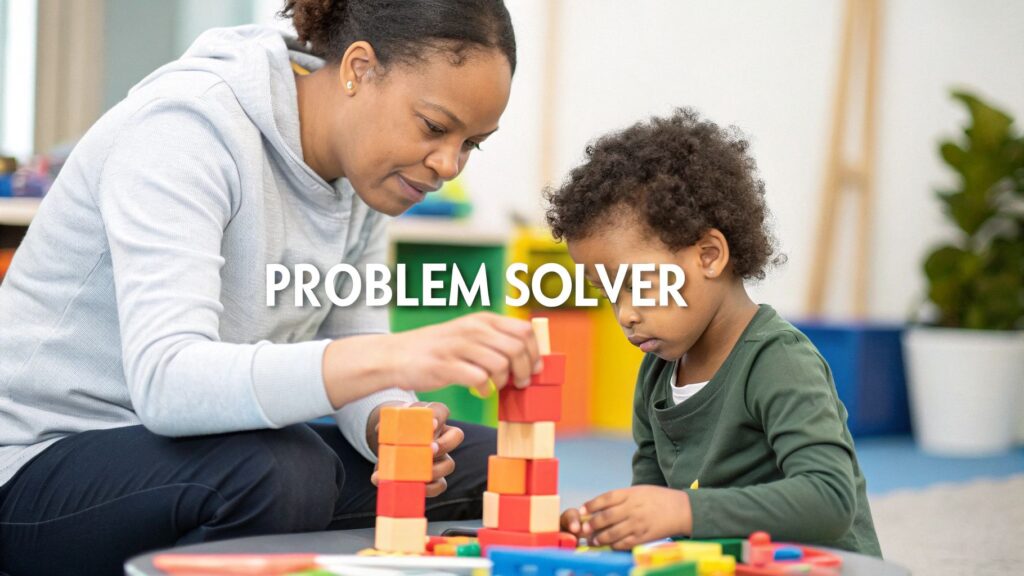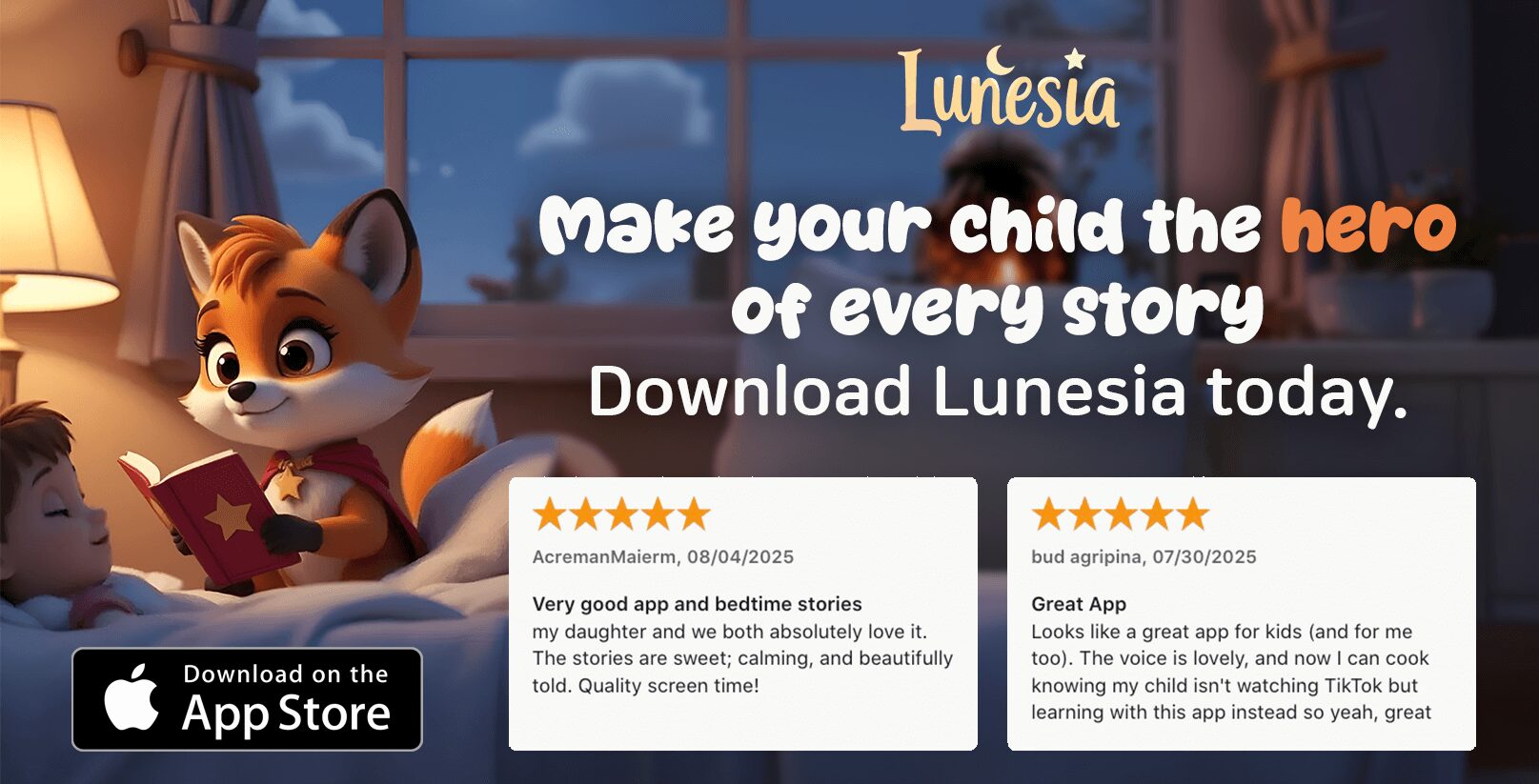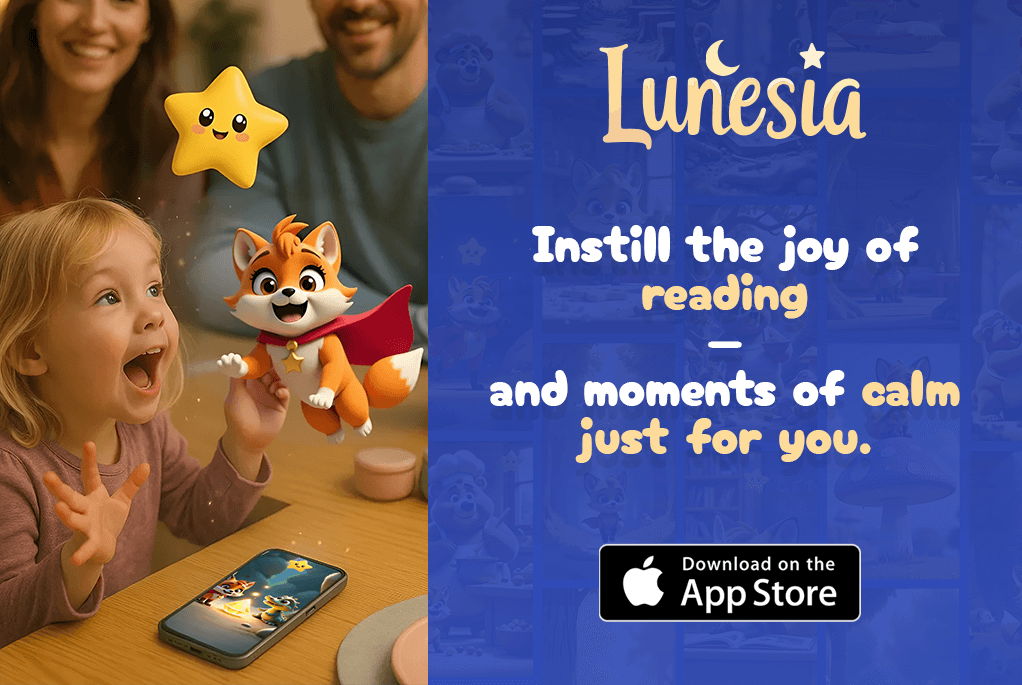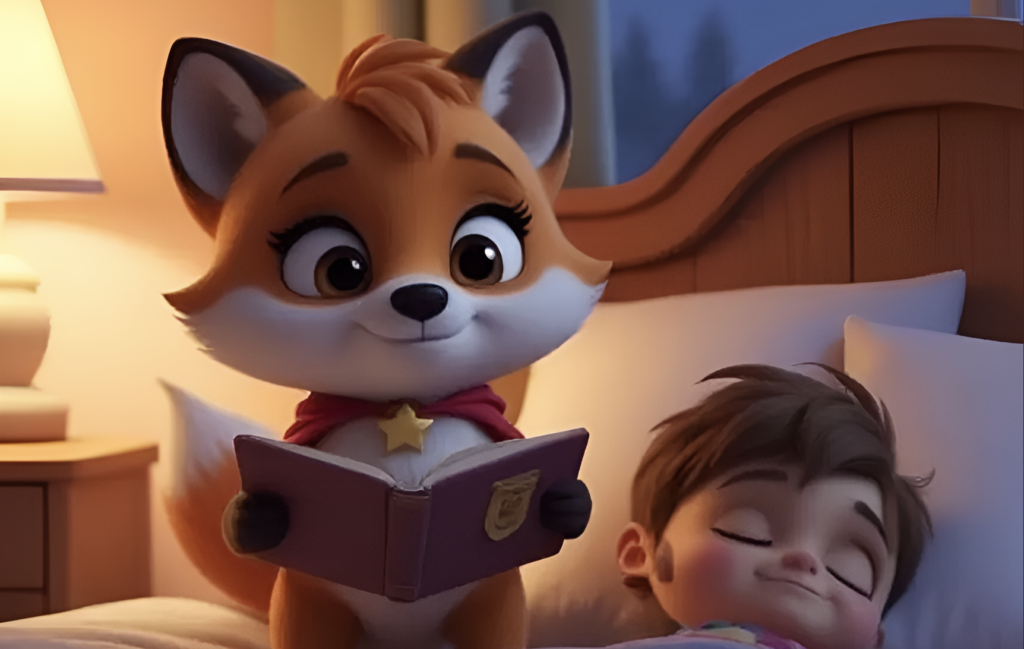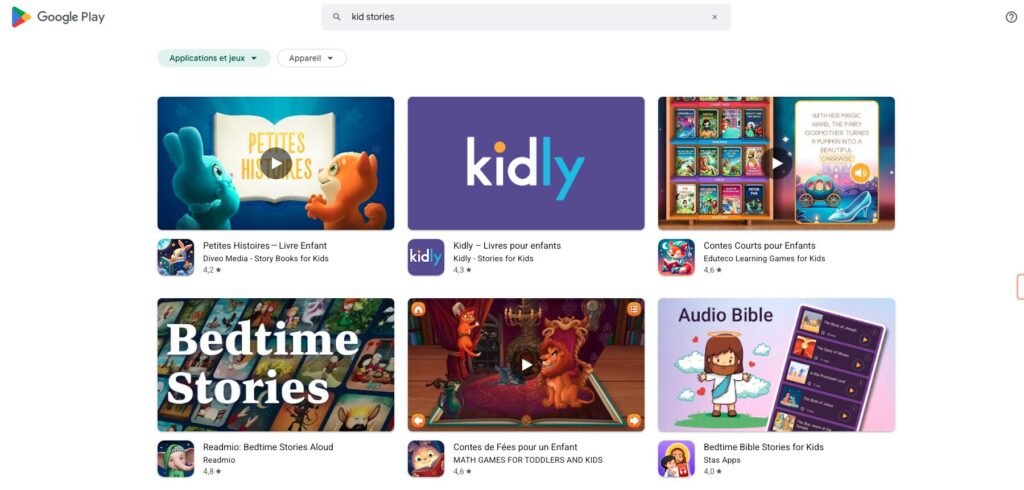Ever watch your child get completely stumped by a stuck zipper or a wobbly tower of blocks and feel that magnetic pull to just swoop in and fix it? Of course, you have. It’s that split-second instinct to erase frustration, but what if, in that moment, we’re accidentally erasing a powerful learning opportunity?
What if the real secret to raising a confident, resilient kid isn’t giving them all the answers? What if it’s showing them they have the power to find the answers themselves?
Why This Skill Is a Game-Changer for Your Child
Curious about what truly prepares a child for the real world? It isn't just knowing letters and numbers. It's the sturdy foundation of problem-solving—a skill that starts with the smallest daily hiccups and builds into a superpower for life. It’s what helps them navigate everything from playground squabbles to, one day, the complexities of the adult world.
Picture a two-year-old trying with all their might to jam a square block into a round hole. It’s almost a comedy sketch, right? But in that moment of focused grunts and a furrowed brow, a little brain is firing on all cylinders. It’s a hands-on lesson in cause and effect, shapes, and the art of trying again.
Now, let's jump to age seven. The problems look different—a falling out with a best friend, a sudden fear of the dark, or the crushing disappointment of a drawing that just won’t turn out right. These aren’t just bumps in the road; they're the real curriculum of childhood. How we guide them through these moments sets the stage for how they’ll face challenges for the rest of their lives.
The goal isn't to clear the path of all problems for our kids. It's to raise kids who are so good at solving problems that they can confidently handle whatever life throws their way.
When we shift our mindset, a spilled cup of juice is no longer just a mess to be cleaned. It's a chance to ask, "Uh oh! What should we do now?" A squabble over a favorite toy becomes a mini-negotiation where empathy and compromise are born.
Turning Everyday Frustrations into Teachable Moments
So, how do we make this happen in the heat of the moment? It starts by resisting that urge to jump in with a solution. Instead, you become a trusted co-pilot on their journey, not the pilot. You're there to guide, not to steer.
The process is simpler than it sounds. It’s about helping them pause, think, and try, rather than reacting with a storm of frustration. This simple framework can turn abstract thinking into concrete, manageable steps for your young child.
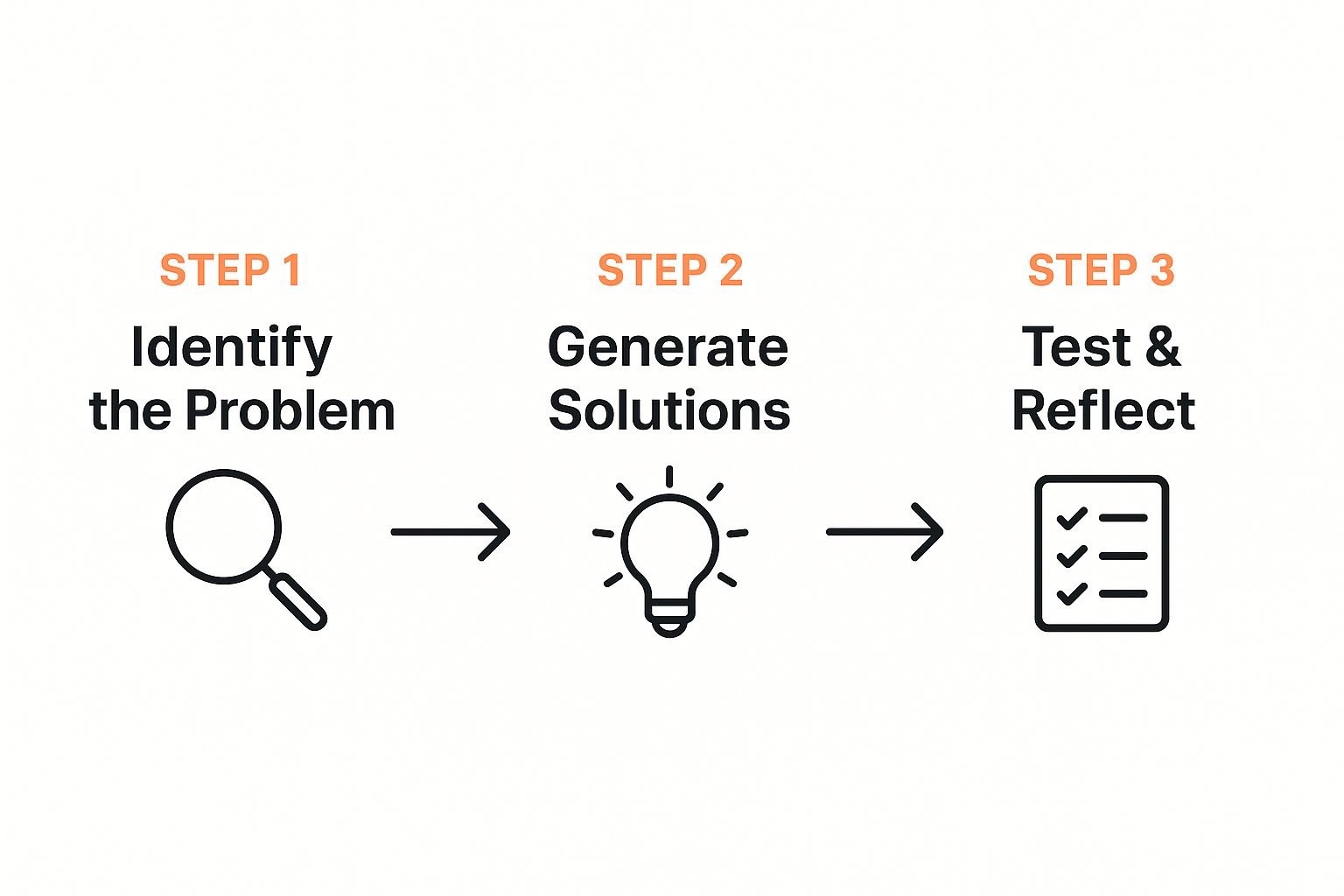
This visual guide helps kids—and us!—remember to slow down and work through the issue instead of getting swamped by it. Building these mental muscles early is critical.
And the data backs this up. A recent OECD survey found that, on average, only about 1 in 10 adults are top performers in problem-solving. This gap often starts in early childhood. By intentionally nurturing these skills from the very beginning, we set our kids on a path to thrive.
I’ve found that the easiest way to start is by reframing those common daily challenges. It's a small change in our reaction that makes a huge difference in their development.
The Everyday Problem-Solving Toolkit for Parents
Curious how this shift looks in real life? Here’s a quick-glance table to help you move from being the "fixer" to being the "guide."
| Common Challenge (Ages 2-7) | Old Reaction (Giving the Answer) | New Approach (Guiding the Thinking) |
|---|---|---|
| A block tower keeps falling over. | "Here, let me show you. Put the big ones on the bottom." | "Oh no! Why do you think it fell? What could we try differently this time?" |
| A zipper is stuck on a jacket. | "Just give it to me, I'll do it." | "Hmm, it looks stuck. What happens if you pull the fabric away from it?" |
| They can't find their favorite toy. | "It's in the red bin. I saw it earlier." | "Where are some places we could look? Where did you last play with it?" |
| Siblings are fighting over one toy. | "Fine, nobody gets it! I'm taking it away." | "You both want it. That’s a tough problem. How can we work this out so you both feel okay?" |
| A drawing gets a "mistake" on it. | "It's okay, we can just get a new piece of paper." | "I see you're frustrated. Could that line become something else? Maybe a tree branch or a river?" |
By using this approach, you're sending a powerful message: "I trust you to think. I believe you can figure this out." It builds a bond of trust and empowers your child with the confidence to try, fail, and try again. That’s an invaluable gift.
For a deeper look at nurturing these abilities, check out Kubrio's Problem Solving skills page.
Turning Frustration into Triumph with Playful Scenarios
We’ve all been there. The magnificent block tower comes crashing down, followed by an earth-shattering meltdown. What’s your first instinct? Probably to race to either rebuild it yourself or distract your little one with a new toy. But what if these tiny moments of frustration are actually golden opportunities in disguise?
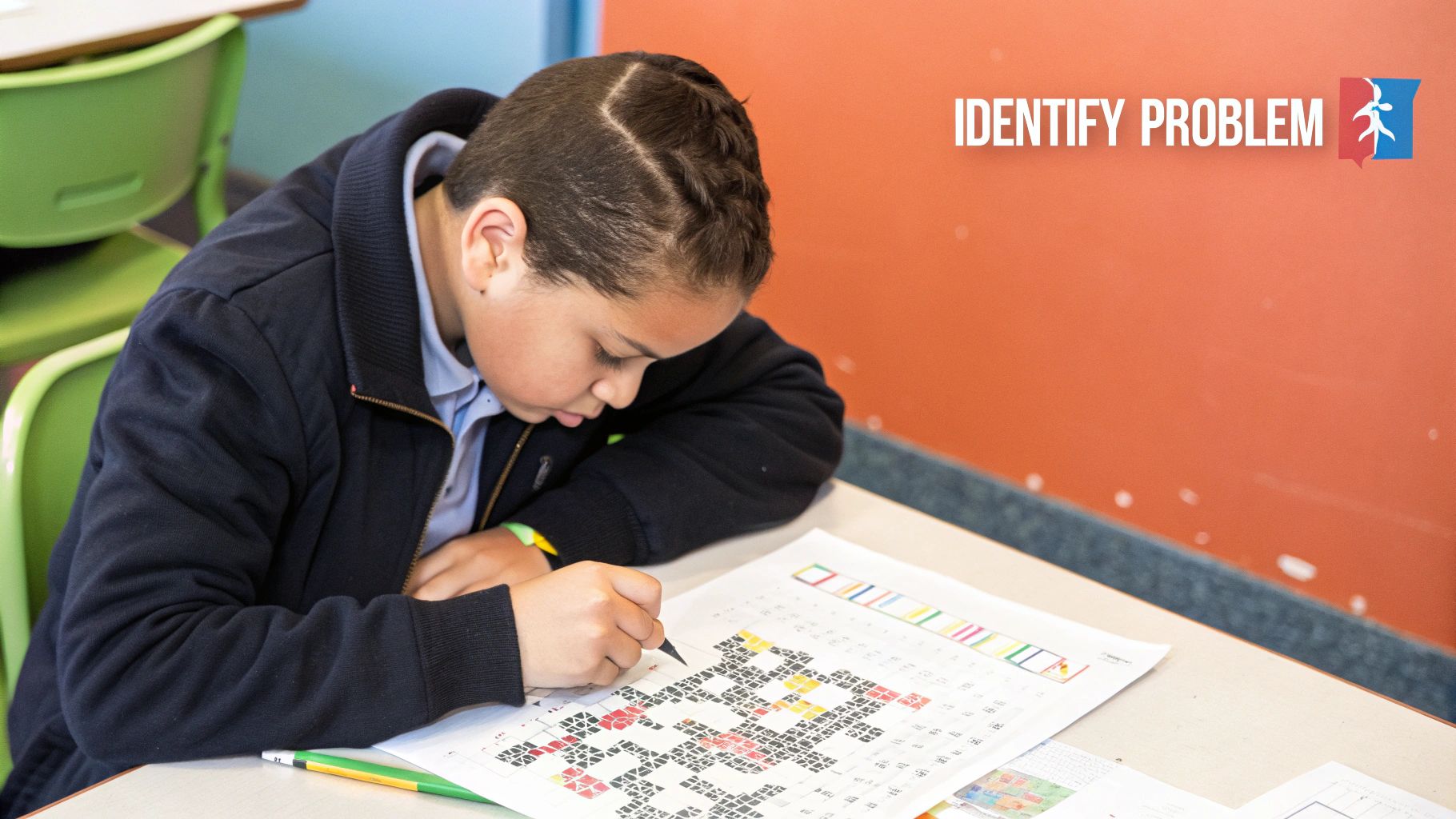
This is your chance to teach problem-solving skills in a way that genuinely sticks. It's about shifting from daily chaos to triumphant learning moments, and trust me, it’s easier than you might think.
Let's look at some real-life scenarios that probably feel very familiar.
From Stuck Zippers to Lost Toys
The jacket zipper gets stuck. The wailing begins. Instead of a sigh and an automatic, "Here, let me do it," try crouching down to their level and becoming a co-conspirator.
A gentle prompt can work wonders: "Oh, that zipper is being so tricky! I wonder what would happen if we pulled the fabric away just a little bit?" You aren't giving the answer; you're sparking curiosity and handing them the power to try.
Or what about the classic "I can't find my blue dinosaur!" crisis? Before launching your own search party, you can ask, "That's a tough one. Where's the very first place we should look? Where were you playing with him last?"
You are shifting their focus from the feeling of being helpless to the action of being helpful. This small change in your language is everything. It tells your child, "You are capable. You have great ideas. I believe in you."
These aren't just one-off tricks; they're the building blocks of resilience. Every time you guide instead of fix, you're strengthening their problem-solving muscles for the future.
Turning Scenarios into Adventures
So, how do you make this feel less like a lesson and more like a game? This is where a modern tool can become a parent’s secret weapon. Imagine turning this exact process—identifying a problem and exploring solutions—into a captivating adventure.
This is precisely the magic behind Lunesia, an app that transforms storytelling into a problem-solving playground. These aren't just bedtime stories—they're engaging, value-rich journeys. In a Lunesia story, a brave knight might need to cross a river without a bridge, or a friendly squirrel might have lost its acorns right before winter. The story then pauses to ask the most important question: What should they do next?
Your child doesn’t just listen—they decide.
- Should the knight build a raft or try to find a shallow spot to cross?
- Should the squirrel retrace its steps or ask a wise owl for help?
Each choice they make shapes the outcome of the adventure. They are actively practicing problem-solving, all within a safe, imaginative world. They see firsthand that their decisions have consequences and that there's often more than one way to tackle a challenge.
Suddenly, the skills they need for a stuck zipper or a lost toy are being sharpened through thrilling, interactive play. They are learning to handle setbacks, think creatively, and show empathy for characters facing their own struggles.
And the best part for you? While your child is deeply engaged in a meaningful, ad-free adventure—building kindness, courage, and emotional resilience—you get that precious, guilt-free time for yourself. You can finally finish that cup of coffee, knowing they aren't just being entertained; they are learning skills for life.
Using Storytelling to Build a Problem-Solving Brain
Have you ever peeked over at your child, completely lost in a good story, and wondered what’s really going on in that little head of theirs? It’s so much more than just quiet time. Stories are like a gym for their developing minds, helping them connect cause and effect, feel what characters feel, and mentally test-drive solutions to problems they haven't even faced yet.
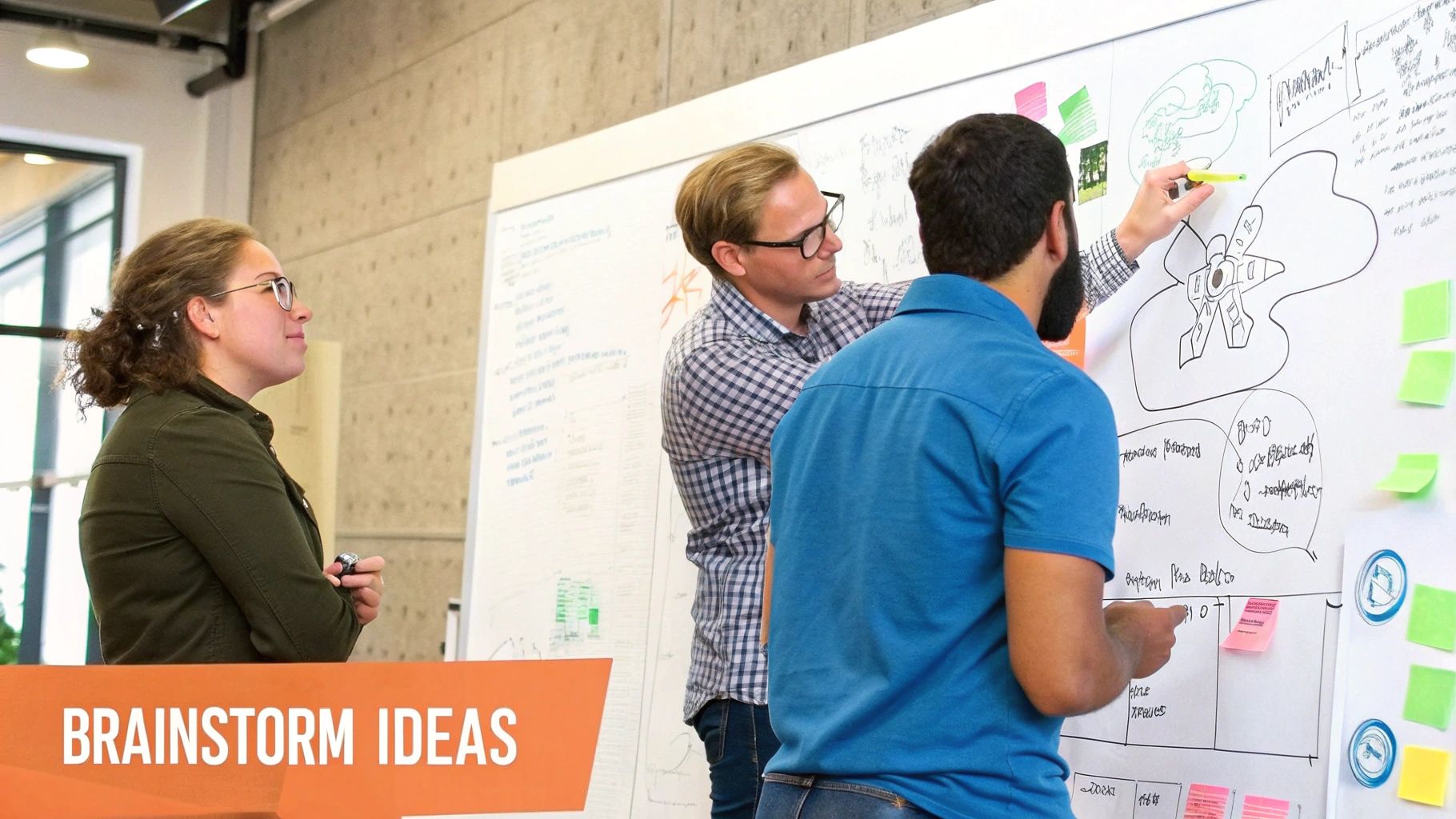
But here’s a little secret I’ve learned over the years: the real magic happens when we shift from just reading a story to our child to reading it with them. This one small tweak turns passive listening into an active, problem-solving conversation. It’s the difference between watching a movie and being part of the cast.
Make Storytime a Dialogue
Think about the last book you read together. I bet a character faced some kind of challenge—maybe a big bad wolf, a lost teddy bear, or a case of the first-day-of-school jitters. Instead of immediately turning the page to see what happens, just pause. That’s your moment. That pause is where you can spark their critical thinking with a few simple, open-ended questions.
Here’s how you can transform any story into a problem-solving brainstorm:
- Before the solution appears, ask: "Oh no, the little goat is stuck on the other side of the bridge! What do you think he could do?"
- When a character shows big feelings, ask: "He looks really frustrated that his kite won't fly. What helps you feel better when you get frustrated?"
- After a character makes a choice, ask: "She decided to share her snack. How do you think that made her friend feel? What do you think would’ve happened if she didn’t share?"
These aren't quiz questions with right or wrong answers; they are genuine conversation starters. You're inviting your child to break down a situation, imagine different outcomes, and think about others' feelings—all core parts of how to teach problem solving skills.
This back-and-forth does more than just fire up their imagination. It’s also building crucial cognitive skills. For instance, strong reading comprehension skills are the bedrock for pulling apart complex problems and finding solutions, both in stories and in real life.
Let Your Child Steer the Adventure
What if your child could do more than just guess what happens next? What if their choice actually changed the story? This is where technology can beautifully support this timeless practice of ours.
We built Lunesia on this very idea. Our interactive stories are designed to take this dialogue to the next level. In a Lunesia story, when a character needs to cheer up a sad friend or figure out how to cross a roaring river, the story pauses. Then, your child gets to make the call.
They aren’t just a passenger on the journey; they are the hero at the helm. Their choices directly influence the plot, leading to different paths and outcomes.
This is more than just fun—it's practice without consequences. When your child helps a shy fox make a new friend or assists a clumsy robot in fixing its invention, they are building a powerful mental toolkit. They learn:
- Empathy: By stepping into a character's shoes and making decisions for them.
- Courage: By helping characters face their fears in a safe, supportive space.
- Creative Thinking: By discovering that most problems have more than one solution.
These adventures are more than just bedtime stories; they’re engaging, value-rich journeys that teach kindness, courage, problem-solving, and empathy, all in a safe, ad-free environment.
And for you, the parent? This offers a moment of peace. You get some precious time for yourself, completely guilt-free, knowing your child isn’t just zoned out in front of a screen. They’re immersed in a safe, ad-free world, actively becoming a kinder, braver, and more resourceful little person.
From Tantrums to Teamwork: Solving Emotional Puzzles
We’ve all been there. That heart-sinking moment when your child’s lower lip starts to tremble because their drawing isn’t perfect. Or the full-blown tantrum over a puzzle piece that just won’t fit. These big emotions can feel overwhelming—for both of you.
But what if we saw these outbursts not as behaviors to manage, but as problems your child is desperately trying to solve?
A tantrum isn't just noise; it’s a distress signal. It’s your child’s way of shouting, "I have a problem I don't have the words or skills to fix!" When we reframe it this way, we shift from being a disciplinarian to becoming an emotional detective and a problem-solving partner. This approach builds emotional intelligence right alongside practical problem-solving.
From "I'm Mad!" to "What's the Plan?"
The first, most critical move is to connect with the feeling before you try to correct the behavior. Instead of a dismissive "Stop crying," get down on their level, make eye contact, and name what you see.
"Wow, you seem really frustrated that your drawing didn't turn out the way you imagined."
This simple act of validation is incredibly powerful. It tells your child, "I see you, I hear you, and your feelings make sense." You're not fixing the problem for them; you're just sitting with them in the feeling for a moment. Once they feel understood, their mind can shift from panic mode to a more receptive, thoughtful state.
Then, you can gently guide them toward finding a solution.
“What do you think would help you feel a little better right now? Is there something we could try to fix the drawing, or should we take a break and do something else for a minute?”
You're not giving them the answer. You’re empowering them to look inward and find their own solution, which builds incredible self-regulation skills. Exploring effective emotional regulation activities for kids is a fantastic way to equip children with practical skills for handling their feelings under pressure.
Building an Emotional Toolkit Through Stories
So, how can we practice these skills before a real-life meltdown strikes? This is where stories become your secret weapon. But not just any stories.
Imagine a world where your child can safely explore big feelings like fear, shyness, or frustration by helping a character navigate them. This is the heart of Lunesia. Our interactive stories are filled with characters who face familiar emotional hurdles—a little bear too shy to join a game, or a brave knight feeling anxious about the dark woods ahead.
The story pauses, and your child gets to help.
- Should the shy bear take a deep breath and say hello, or should he watch from a distance for a while?
- Should the knight sing a happy song to feel brave, or should he ask a firefly to light the way?
By making these decisions, your child is building a rich emotional toolkit. They're learning that it’s okay to feel scared or sad and that there are concrete things you can do to move through those feelings. They're practicing empathy and building emotional resilience in a safe, ad-free environment where every choice reinforces courage. For more ideas, you can explore our guide on how to help a child manage frustration.
And the bonus for you? As your child is immersed in these meaningful adventures, learning kindness and self-control, you get precious time back for yourself. It’s guilt-free, because you know they aren’t just being distracted—they are building the emotional resilience they need to thrive.
How Guilt-Free Screen Time Can Be Your Secret Weapon
Let’s be honest for a second, just between us. Have you ever felt that tiny twinge of guilt when you hand over a tablet to your child just so you can have five uninterrupted minutes to yourself? Every parent has. That feeling comes from a deep desire to do what’s best for our kids, but what if that screen time could actually be what’s best?
What if those precious minutes could be genuinely productive, actively building the skills we’ve been talking about? The secret isn’t to eliminate screen time—it's to elevate it. It’s about drawing a clear, bold line between passive consumption (like zoning out to endless videos) and active, engaging experiences that ignite their curiosity.
The Difference Between Numbing and Nurturing
Think of it like this: passive screen time is like sitting on a stationary bike. The pedals might be moving, but you’re not really going anywhere. It’s a distraction, a way to pass the time.
Active, high-quality screen time, on the other hand, is like giving your child a map and a compass for an exciting treasure hunt. They have to think, decide, and engage. This is where a tool like Lunesia becomes your partner in parenting. It’s designed to be the complete opposite of mindless scrolling.
Our children aren’t just looking at a screen; they are stepping into a world where they are the hero. When a character faces a dilemma, your child’s choice steers the story, teaching them firsthand that their decisions matter.
While they’re immersed in a meaningful adventure—making choices, solving problems, and learning about kindness—you get that much-needed time for yourself. It’s the ultimate win-win. You can finally sip your coffee while it's still hot, knowing your child is safe, learning, and in a completely ad-free world.
For a deeper look into this approach, you can explore our thoughts on making the most of guilt-free screen time with Lunesia.
Preparing Them for a World We Can't Yet Imagine
Fostering these skills through positive digital experiences is more important than ever. After all, we're not just teaching them to navigate childhood; we're preparing them for a future where technology is woven into the fabric of daily life. The ability to use technology to solve problems is no longer a niche skill—it’s essential.
Recent data from the Survey of Adult Skills (PIAAC) reveals a significant gap in these abilities among adults. For instance, only 36% of U.S. adults demonstrated proficiency in using technology to solve problems, a stark contrast to 56% in Japan. By giving our children positive, interactive digital experiences now, we’re laying a foundation for them to thrive in the world they will inherit. You can discover more insights about these findings on OECD.org.
This isn't about raising tech geniuses; it’s about raising adaptable, resourceful human beings who see challenges as opportunities, whether on a screen or in the real world.
When your child helps a Lunesia character navigate a tricky situation, they aren’t just playing a game. They are actively:
- Building emotional resilience by helping characters overcome fear and frustration.
- Practicing empathy by considering how their choices affect others in the story.
- Strengthening critical thinking by weighing different options to solve a problem.
This is how we transform a moment of need into a moment of growth. You recharge your own batteries, and your child sharpens the very tools they need to build a confident, capable future. That’s not guilt-worthy; that’s brilliant parenting.
Frequently Asked Questions About Problem Solving

Diving into teaching problem-solving skills is an exciting journey, but it’s totally normal to have questions pop up. You’re navigating a huge part of your child’s development, so seeking a little clarity is a great sign you’re on the right track. Think of me as that friend who’s already been there, ready to share what I've learned over a warm cup of coffee.
Here are some of the most common questions I hear from parents just like you.
My 3-Year-Old Just Gets Frustrated and Gives Up. How Can I Help?
First, take a deep breath. This is so, so normal. At age three, a child's world is full of things they can't quite do yet, and their frustration tolerance is still tiny. The real goal right now isn't for them to solve the puzzle, but to learn how to handle that sticky feeling of being stuck.
Start by shrinking the problem. Instead of a 20-piece puzzle, focus on one single, achievable step, like turning one piece around to see if it fits. Acknowledge their big feelings with empathy: "It's so tricky when the blocks keep falling down, isn't it?"
Then, model curiosity. Wonder aloud with them: "Hmm, I wonder if this big block would work better on the bottom?" The most important part is to celebrate their effort, not just the final result. A warm, "I love how you kept trying to fit that piece!" shows them that the process of trying is what truly matters.
This is where an app like Lunesia can be a game-changer. These aren’t just bedtime stories—they're interactive adventures. The "problems" are part of a fun story, so the stakes feel low. When your child helps a character decide which path to take, they’re practicing this exact skill without the real-world frustration, making it a joy to try again.
How Do I Balance Helping My Child with Letting Them Struggle?
Ah, the great parenting tightrope walk! Finding that sweet spot between swooping in to rescue and letting them flail is an art form. The key is what educators often call "scaffolding." You aren’t building the tower for them, but you’re holding it steady just enough so they don’t give up.
Think of yourself as a trusted guide, not the hero of the story. Your best tool? The "I wonder…" statement.
- "I wonder what would happen if we tried turning the jar lid the other way?"
- "I wonder if the red crayon would look good there?"
This gives them a powerful clue without just handing over the answer. Just as crucial is learning to embrace the pause. Before you jump in, count to ten in your head. That brief moment of silence is often where the magic happens—where their own little lightbulb flickers on.
If they're truly melting down, it's okay to help with one small part of the task. "How about I hold the paper steady for you, and you can try doing the cutting?" This teaches them that collaboration is also a brilliant problem-solving strategy.
Your goal isn't to remove the struggle, but to show them they are strong enough to get through it—sometimes with a little support from someone who believes in them.
Is It Okay to Use an App to Teach These Skills?
This is such a valid and important question for every modern parent. The guilt around screen time is real, but I want to be clear: not all screen time is created equal. The most important thing is to differentiate between passive consumption and active engagement.
Passive time is like watching a TV show—the brain is just absorbing content. Active time, the kind you'll find in Lunesia, is entirely different. It requires your child to think, to choose, and to participate. It’s the digital version of a choose-your-path book or an interactive museum exhibit.
When used with intention, a high-quality app becomes a powerful educational partner, not just a digital babysitter. It’s all about quality over quantity.
Think about it this way: 20 minutes spent in a Lunesia story where your child helps a character show kindness or bravely face a fear is far more enriching than an hour of passively watching random videos. It’s a tool that provides guilt-free time for you and a genuinely meaningful learning experience for them.
Ready to turn everyday challenges and screen time into powerful opportunities for growth? With Lunesia, you can give your child a universe of interactive stories that build the skills that matter most.
Start your free trial today and watch your little hero grow!
Article created using Outrank
